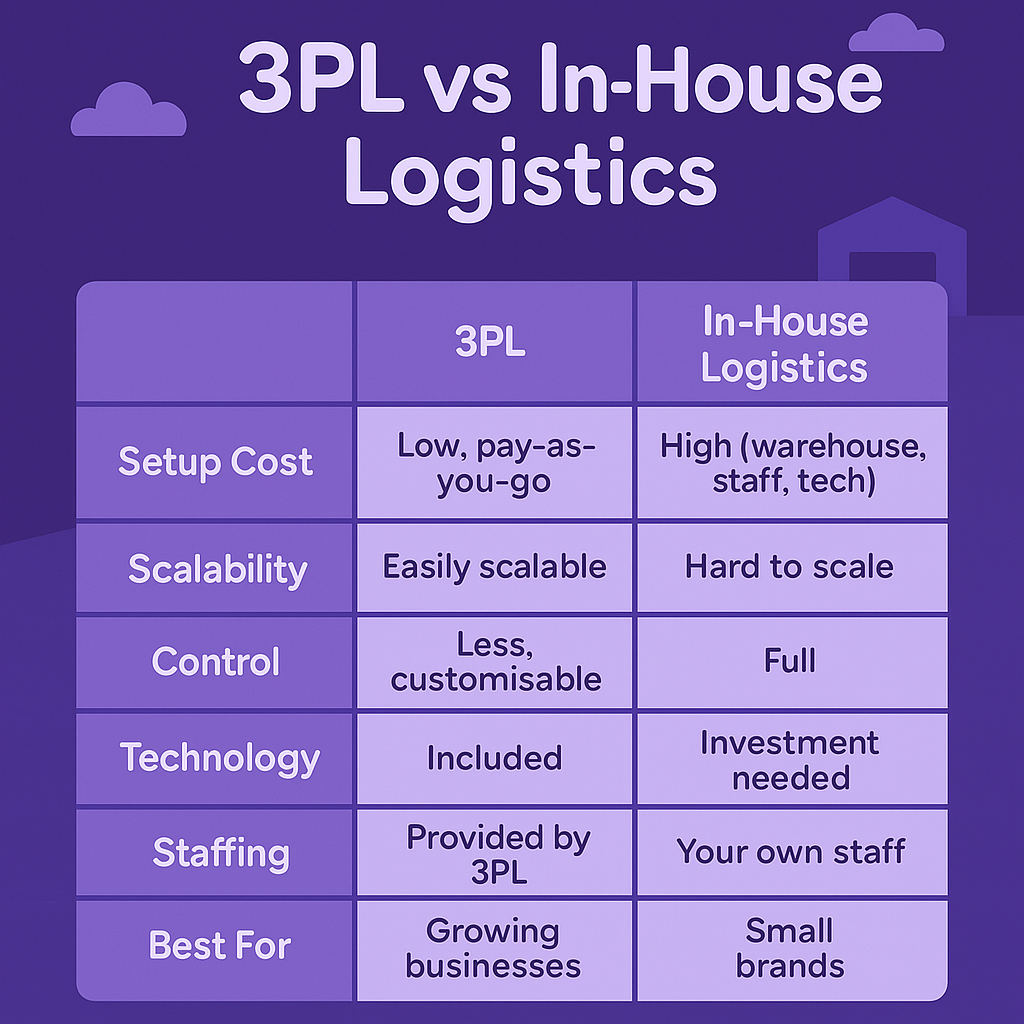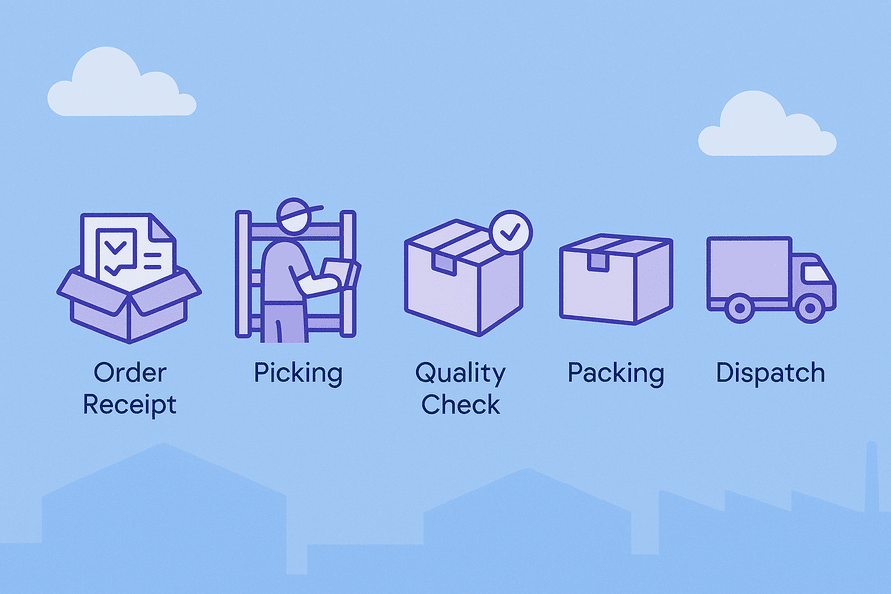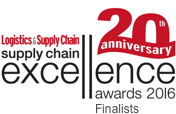Article Takeaways
- 3PL offers scalable, cost-effective logistics solutions for growing eCommerce businesses.
- In-house logistics provide full control but come with high operational costs and scaling challenges.
- 3PL providers offer advanced technology, seamless integrations, and real-time inventory tracking.
- In-house logistics are ideal for small businesses with manageable order volumes and a focus on customisation.
- Choosing between 3PL and in-house logistics depends on business size, growth stage, and specific operational needs.
- Hybrid models can combine in-house control with the efficiency of 3PL outsourcing for optimal flexibility.
- Cloud Fulfilment provides tech-driven, scalable solutions to help businesses navigate logistics challenges and scale effectively.
3PL vs In-House Logistics: Which is Right for Your eCommerce Business?
Managing logistics is one of the biggest challenges for eCommerce businesses today. With rising shipping costs, customer expectations for faster delivery, complexities in inventory management, and the pressure to scale during peak seasons, it’s easy for logistics to become a barrier to growth.
That’s where Cloud Fulfilment comes in. We specialise in providing cutting-edge, tech-driven logistics solutions that help businesses tackle these common challenges. By leveraging real-time data, automation, and seamless integrations with platforms like Shopify and WooCommerce, Cloud Fulfilment streamlines supply chains, making it easier for businesses to meet customer demands.
We also understand the unique needs of specific markets, including pet accessories and subscription box fulfilment. Whether you’re facing the challenge of scaling quickly or simply need to improve efficiency, Cloud Fulfilment can help you decide whether to outsource to a 3PL provider or manage your fulfilment in-house.
In this article, we’ll explore the differences between 3PL and in-house logistics, helping you make the best choice for your business’s growth and operational needs.
What Are 3PL and In-House Logistics?
What is Third-Party Logistics (3PL)?
Third-party logistics (3PL) refers to outsourcing your warehousing, inventory management, order picking and packing, and shipping processes to a specialist logistics partner.
A 3PL provider offers a wide range of fulfilment services, including returns management, kitting and subscription box assembly, and multi-channel order handling. Working with a 3PL allows businesses to scale their logistics operations without the need to manage a warehouse, hire staff, or invest in infrastructure.
Many 3PL providers also deliver advanced order fulfilment solutions and picking and packing services, often supported by modern technology that integrates seamlessly with platforms like Shopify, WooCommerce, and Amazon — enabling smooth order processing and real-time inventory visibility across multiple sales channels.
What is In-House Logistics?
With in-house logistics, all fulfilment operations are managed directly by the business. This means taking responsibility for renting or owning warehouse space, hiring and overseeing staff, purchasing equipment, and managing shipping and returns internally.
While in-house logistics gives businesses full control over their customer experience, packaging, and branding, it also comes with significant operational responsibilities. For smaller or niche brands, a hands-on approach can make sense — particularly if order volumes are still manageable or if products require custom or highly personalised packaging.
However, as demand grows, scaling in-house logistics often requires major investment in additional staff, warehouse space, and operational systems, making it harder to maintain efficiency and keep up with customer expectations for fast and accurate delivery.
Comparing 3PL and In-House Logistics
1. Costs
The cost of running logistics in-house can be substantial. Warehouse rent, employee wages, insurance, equipment, and technology systems all add up — and these costs are largely fixed, whether you’re shipping 100 or 10,000 orders a month.
On the other hand, 3PL providers usually operate on a pay-as-you-go basis, charging fees for storage, picking, packing, and shipping. This model gives eCommerce brands greater flexibility and predictability, especially when experiencing seasonal peaks or rapid growth. For businesses scaling up, outsourcing to a 3PL can eliminate the need for expensive upfront investments and make costs more manageable over time.
For a clearer breakdown of what you can expect to pay, our fulfilment pricing page offers detailed insights into how 3PL fees work.
2. Technology
Running an efficient in-house fulfilment operation requires significant investment in technology, including inventory management systems, shipping integrations, and order tracking solutions. Maintaining and updating these systems can be costly and time-consuming.
By contrast, many 3PL providers offer cutting-edge technology as part of their service. For example, Cloud Fulfilment’s technology integrates directly with platforms like Shopify and WooCommerce, providing real-time order tracking, automated inventory updates, and seamless multi-channel sales management.
Having access to enterprise-level logistics technology without the upfront investment can give businesses a significant advantage when it comes to efficiency, accuracy, and customer satisfaction.
3. Scalability
One of the biggest limitations of in-house fulfilment is scaling. If your business grows quickly, you may need to lease more warehouse space, hire additional staff, and invest in more equipment — all of which take time and money.
On the other hand, 3PL providers are built for scalability, with existing warehouse infrastructure and trained staff ready to handle increased demand. Whether you’re launching new products, experiencing a surge in orders, or expanding internationally, a 3PL can adjust capacity quickly, helping you avoid costly mistakes or delays.

Advantages and Disadvantages of In-House Logistics
Advantages of In-House Logistics
- Full control over every aspect of the fulfilment process, including packaging, branding, and customer communication.
- Greater flexibility for handling unique, complex, or highly customised products that require special attention.
Disadvantages of In-House Logistics
- Significant ongoing costs, including warehouse space, staff salaries, equipment, and technology.
- Difficult to scale quickly when faced with sudden spikes in demand or rapid business growth, requiring further investment in resources and infrastructure.
Advantages and Disadvantages of 3PL
Advantages of 3PL
- No need to manage warehouses, staff, or equipment — allowing businesses to focus on growth and core activities.
- Fast and accurate fulfilment driven by established processes and advanced technology.
- Ability to reach international markets, with many providers offering services like TikTok Shop fulfilment and other marketplace integrations.
- Access to logistics expertise and real-time data insights, without the burden of building and maintaining in-house systems.
Disadvantages of 3PL
- Less direct control over packaging, branding, and aspects of the customer experience (though many 3PL providers offer customisation to mitigate this).
How to Choose Between 3PL and In-House Logistics
Deciding between in-house and 3PL logistics comes down to understanding your business’s size, growth trajectory, and specific needs.
If you’re a small business with manageable order volumes, in-house logistics might give you the control and flexibility you want. But as your business grows, managing fulfilment in-house can quickly become overwhelming and costly.
Brands operating in specific sectors, like animal and pet accessory fulfilment or subscription box services, may benefit from 3PL partners who offer custom kitting solutions, bespoke packaging, and flexible order management.
Integration with sales platforms is another crucial factor. If you’re selling through Shopify, WooCommerce, or marketplaces like Amazon, seamless order fulfilment is essential. Many 3PLs, including Cloud Fulfilment, offer plug-and-play integrations, so your sales channels automatically sync with your warehouse operations.
Why Choose Cloud Fulfilment?
Cloud Fulfilment helps businesses navigate the in-house vs outsourcing logistics dilemma with a focus on tech-driven, scalable solutions. Our services include:
- Automated fulfilment and real-time inventory tracking for better visibility and fewer errors.
- Scalable solutions that flex with your business as you grow — without needing to invest in more warehouse space or staff.
- Customer-first fulfilment — with fast shipping, bespoke packaging, and kitting options for brands that want to delight their customers.
We specialise in helping businesses that need custom packaging, subscription box kitting, or flexible fulfilment services that grow with their brand.
Choosing between 3PL and in-house logistics is a critical decision for eCommerce brands. While in-house logistics can work for smaller brands needing full control, 3PL offers a scalable, cost-effective solution for growing businesses that want to avoid logistics headaches.
If you’re unsure which path is right for you, Cloud Fulfilment is here to help you explore your options. Whether you’re looking to scale, streamline operations, or simply free up time to focus on growth, we offer flexible fulfilment solutions tailored to your business needs.

Frequently Asked Questions About 3PL vs In-House Logistics
What are the potential risks associated with outsourcing to a 3PL, and how can I mitigate them?
Outsourcing to a 3PL can lead to a loss of control over packaging and shipping. To mitigate this, choose a 3PL that offers customisation options, clear service agreements, and real-time tracking to maintain visibility and ensure a consistent customer experience.
How do I evaluate and compare different 3PL providers to find the best fit for my business?
Consider factors like platform integrations, scalability, technology, and customer service. Test the provider on a small scale first and check their track record with similar businesses to ensure they meet your specific needs.
What kind of businesses are usually a good fit for doing logistics in-house?
In-house logistics is ideal for small or niche businesses with manageable order volumes or highly customised products, where control over branding and packaging is essential.
How can I streamline my in-house logistics operations to make them more efficient before deciding if 3PL is right for me?
Focus on improving processes through automation, optimising warehouse layout, and using inventory management software to reduce errors and improve efficiency before deciding to switch to 3PL.
Are hybrid models (doing some logistics in-house and outsourcing others) viable, and if so, how do they work?
Yes, hybrid models are viable. You can manage high-touch, custom orders in-house while outsourcing standard fulfilment tasks like warehousing and shipping to a 3PL for flexibility and efficiency.
What are the long-term implications of choosing 3PL vs. in-house logistics for my business’s brand and customer relationships?
3PLs can offer scalability and efficiency but may impact direct control over branding and customer experience. In-house logistics allow for more control, but as the business grows, it may become harder to scale efficiently without compromising service quality.


